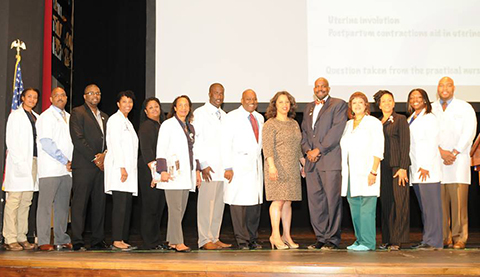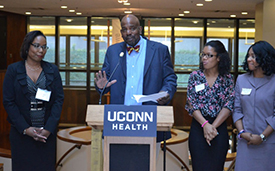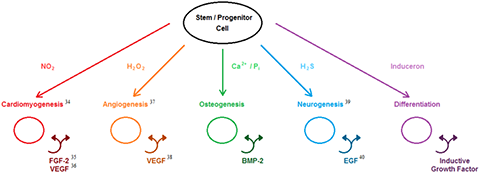 On February 7th and 8th, I participated in the 2015 Musculoskeletal Development and Regeneration Conference in Cancun, Mexico. My speech, “Regenerative Engineering: The Theory and Practice of a Next Generation Field,” highlighted the future of regenerative engineering in musculoskeletal repair and regeneration. I discussed the challenge of musculoskeletal tissue engineering and several of the latest inventions developed by the Institute for Regenerative Engineering here at UConn Health including a bioengineered matrix for the regeneration of torn anterior cruciate ligaments. I want to thank the organizers for including me as part of this for those working on the frontiers of science in both academia and corporate industry.
On February 7th and 8th, I participated in the 2015 Musculoskeletal Development and Regeneration Conference in Cancun, Mexico. My speech, “Regenerative Engineering: The Theory and Practice of a Next Generation Field,” highlighted the future of regenerative engineering in musculoskeletal repair and regeneration. I discussed the challenge of musculoskeletal tissue engineering and several of the latest inventions developed by the Institute for Regenerative Engineering here at UConn Health including a bioengineered matrix for the regeneration of torn anterior cruciate ligaments. I want to thank the organizers for including me as part of this for those working on the frontiers of science in both academia and corporate industry.
Author: Melanie L Burnat
Regenerative Engineering and Translational Medicine
 I am very happy to announce the launch of a new journal entitled Regenerative Engineering and Translational Medicine. It will be published quarterly beginning in later 2015.
I am very happy to announce the launch of a new journal entitled Regenerative Engineering and Translational Medicine. It will be published quarterly beginning in later 2015.
Regenerative Engineering and Translational Medicine is an international journal covering the convergence of tissue engineering, advanced materials science, stem cell research, the physical sciences, and areas of developmental biology. This convergence brings exciting opportunities to translate bench-top research into bedside methods, allowing the possibility of moving beyond maintaining or repairing tissues to regenerating them. The journal also features sections on instructive biomaterials, stimuli-responsive biomaterials, micro- and nano-patterning for regenerative engineering, elastomeric biomaterials, hydrogels for tissue engineering, and rapid prototyping and bioprinting approaches.
We are fortunate to be developing an editorial board of recognized experts in their fields to help with the peer-review process. As editor-in-chief, I want to thank everyone involved for their efforts during the past months in ensuring the journal’s successful launch.
Third Annual Healthcare and Science Stars of Tomorrow Career Symposium
 On February 21, I gave the keynote speech at the symposium sponsored by the T. Leroy Jefferson Medical Society at Inlet Grove Community High School in Riviera Beach, Florida. This event featured healthcare, science, and engineering professionals giving career-exploration talks to elementary, middle and high school students from Palm Beach County. My talk focused on career offerings in both healthcare and STEM. The symposium was a wonderful success. The T. Leroy Jefferson Medical Society is comprised of dedicated healthcare professionals working together to improve health and wellness, access to quality care, academic and career opportunities, for underserved populations. I hope every student took advantage of all R. Leroy Jefferson Medical Society had to offer on the symposium day. I want to thank the organizers and, in particular, Dr. Roger Duncan for inviting me to participate in this wonderful event.
On February 21, I gave the keynote speech at the symposium sponsored by the T. Leroy Jefferson Medical Society at Inlet Grove Community High School in Riviera Beach, Florida. This event featured healthcare, science, and engineering professionals giving career-exploration talks to elementary, middle and high school students from Palm Beach County. My talk focused on career offerings in both healthcare and STEM. The symposium was a wonderful success. The T. Leroy Jefferson Medical Society is comprised of dedicated healthcare professionals working together to improve health and wellness, access to quality care, academic and career opportunities, for underserved populations. I hope every student took advantage of all R. Leroy Jefferson Medical Society had to offer on the symposium day. I want to thank the organizers and, in particular, Dr. Roger Duncan for inviting me to participate in this wonderful event.
Frontiers in Bioengineering Symposium
On September 8th and 9th last year, I served as an invited speaker at the University of Illinois at Urbana-Champaign’s Frontiers in Bioengineering Symposium. This year, the symposium drew more than 200 participants and 30 top scientists/engineers from across the country who presented their forward-looking research in bioengineering. In my talk, “Regenerative Engineering: Theory and Practice,” I discussed the new research direction in the regeneration of musculoskeletal tissues through the regenerative engineering approach. I am grateful to both the organizing committee and the university for inviting me to speak.

First Anniversary of the Research Journal Dedicated to Health Disparities
 This month, we are celebrating the first anniversary of the Journal of Racial and Ethnic Health Disparities, an online health science journal dedicated to examining and eliminating racial and ethnic health disparities.
This month, we are celebrating the first anniversary of the Journal of Racial and Ethnic Health Disparities, an online health science journal dedicated to examining and eliminating racial and ethnic health disparities.
Since the official launch in July 2013, we have received an impressive number of high quality submissions from scholars all over the world. We hoped to have 40 publications the first year. Currently we have over 80 manuscripts for publication of extremely high quality. We have published articles on important areas such as HIV-related mortality among adults of various minority groups; cancer risk among African-Americans; and obesity and related chronic health conditions among ethnic minorities.
The Journal of Racial and Ethnic Health Disparities will continue to update the community on new research findings, commentaries, insights, and discussions that are relevant to the health disparities. I would like to thank our associate editors, editorial board members, and editorial staff for all of their excellent work.
NIH’s Building Infrastructure Leads to Diversity Award
 The Connecticut Institute for Clinical and Translational Science (CICATS) at UConn has been selected to take part in a new NIH initiative, Building Infrastructure Leading to Diversity (BUILD), designed to enhance diversity in the biomedical research field. The initiative’s goal is attracting minority students to the STEM workforce and encouraging them to become future contributors to the NIH-funded research enterprise.
The Connecticut Institute for Clinical and Translational Science (CICATS) at UConn has been selected to take part in a new NIH initiative, Building Infrastructure Leading to Diversity (BUILD), designed to enhance diversity in the biomedical research field. The initiative’s goal is attracting minority students to the STEM workforce and encouraging them to become future contributors to the NIH-funded research enterprise.
Part of a multi-institution consortium led by the University of Texas at El Paso tasked with developing these new opportunities, CICATS was invited to contribute to the grant because of its successful track record in creating pipeline programs such as the Young Innovative Investigator Program (YIIP) and the M1 Mentorship Program. As a major contributor and recipient of a BUILD award, CICATS will oversee the execution of the program here at UConn.
Correcting the imbalance of STEM workforce requires advances in research, engineering, and medicine, community outreach and changes to public policy. CICATS’ goal is bringing the necessary change makers together through the BUILD award to help facilitate the exchange of ideas and collaborations across multiple disciplines.
Torch of Liberty Award Reception
 On October 7th, the Anti-Defamation League presented the Torch of Liberty Award to Mr. Max Javit and me. The award recognizes individuals who demonstrate an exceptional commitment to community, justice, and equal opportunity for all. I was deeply honored and humbled to receive it.
On October 7th, the Anti-Defamation League presented the Torch of Liberty Award to Mr. Max Javit and me. The award recognizes individuals who demonstrate an exceptional commitment to community, justice, and equal opportunity for all. I was deeply honored and humbled to receive it.
The ADL was founded in 1913 to stop the defamation of the Jewish people and to secure justice and fair treatment for all. Now one of the nation’s premier civil rights/human relations agencies, it fights anti-semitism and all forms of bigotry, defends democratic ideals, and protects civil rights for all. I am very pleased to be associated with the ADL and its membership. It is an amazing organization.
NIH Director’s Pioneer Award
In early September, I was honored to be named one of ten scientists chosen to receive a National Institutes of Health (NIH) Director’s Pioneer Award. The Pioneer Award funds innovative research proposals which attack challenging biomedical problems. Established ten years ago, this award encourages the kind of forward-looking research scientists once complained was difficult to find funding for under the traditional NIH grant structure. It is designed to support “a small number of investigators of exceptional creativity who propose bold and highly innovative new research approaches that have the potential to produce a major impact” in the fields of biomedicine and behavioral research, according to the NIH. I am grateful to receive this award from among such a competitive group. It will allow us the intellectual freedom and resources to develop a brand new technology. If successfully implemented, the technology will impact many disciplines of biomedical research, including biomaterials development, regenerative engineering, developmental biology, drug delivery, and stem cell biology.
Institute for Regenerative Engineering Receives a New NIH Award
Institute for Regenerative Engineering faculty members Dr. Lakshmi Nair (PI) and Dr. Kevin Lo (PI), as well as Dr. Joseph Walker (Co-I) from Orthopaedic Surgery and I (Co-I), have received funding from the NIH/NIAMS for a study aimed to develop a novel injectable analgesia delivery system. Current analgesia formulations have been limited by their relatively short duration of action requiring repeated administrations. In addition, local anesthetics are often associated with systemic toxicity and local tissue-site inflammatory responses. To address these issues, our project will develop a novel injectable analgesia delivery system lasting up to 7 days with minimal side effects.
This award highlights collaborative efforts between the IRE and Orthopaedic Surgery. We hope to continue combining the creativity and dedication of our scientists and clinicians.
Simple Signaling Molecules (Induceron)
The Institute for Regenerative Engineering’s latest research paper, “Simple Signaling Molecules for Inductive Regenerative Engineering”, has been accepted for publication by the high-impact peer-reviewed journal, PLoS One. Written by researchers from our institute, the University of Virginia, the Hospital for Special Surgery in New York, and SASTRA University in India, this paper represents a paradigm shift in the field of regenerative engineering wherein simple signaling molecules can be utilized in place of recombinant protein growth factors.
The results presented in this report corroborate our novel theory that the simple signaling molecules of calcium and phosphate ions possess intrinsic bone-formation activity which is carried out by the induction of cell-based bone-formation protein-growth factor (Bone Morphogenetic Protein-2, BMP-2) production and secretion. In addition, a review of published biochemical research has revealed that a number of simple signaling molecules exist that possess similar behavior to calcium and phosphate ions which we have collectively termed inducerons (see figure). These small molecules are uniquely capable of inducing stem- and progenitor-cell differentiation down desired lineages utilizing protein growth factor-based inductive loops. The problems associated with using BMP-2 in bone graft substitutes such as cost and long-term safety are also issues with utilizing protein growth factors in other translational biomedical engineering strategies. Since these inductive molecules can be released from stable, inexpensive materials (e.g., CaP), their long-term delivery can be achieved through a wide variety of controlled release strategies compared to the relatively few options available for fragile, expensive protein growth factors. Utilizing the principles of biology, engineering, morphogenesis, stem cell technology, and materials cues, regenerative engineering represents a novel approach in which the body is induced to regenerate its own complex tissues and organs. This new concept of inducerons may compel regenerative engineering strategies to become the gold standard in complex tissue- and organ-replacement therapies.

Figure was adapted from Cushnie EK, Ulery BD, Nelson SJ, Deng M, et al. (2014) Simple Signaling Molecules for Inductive Bone Regenerative Engineering. PLoS ONE 9(7): e101627.